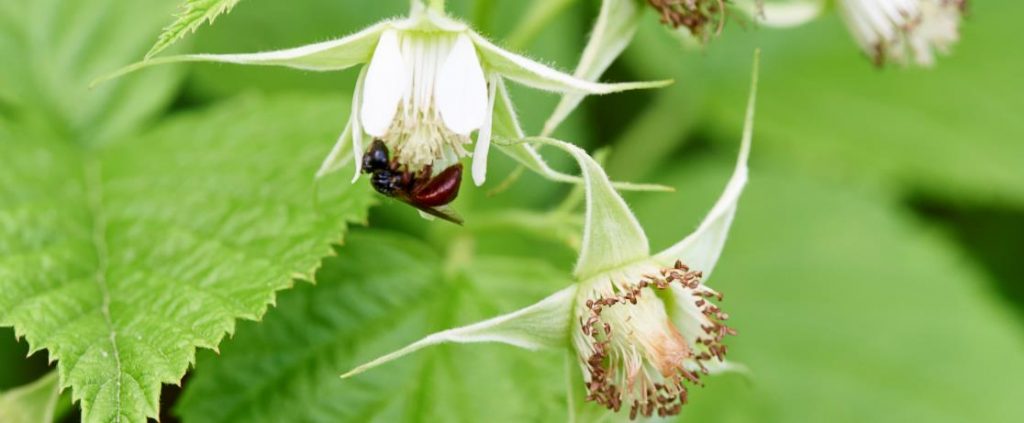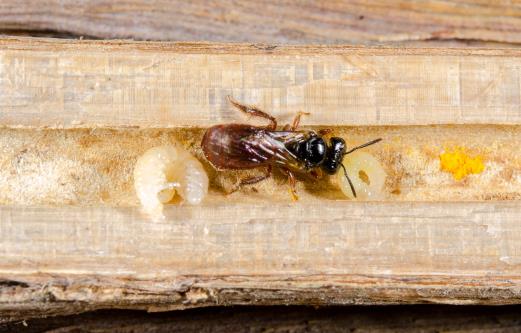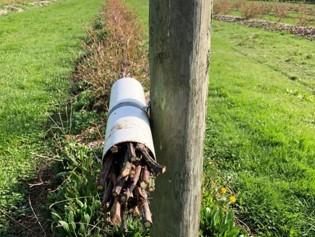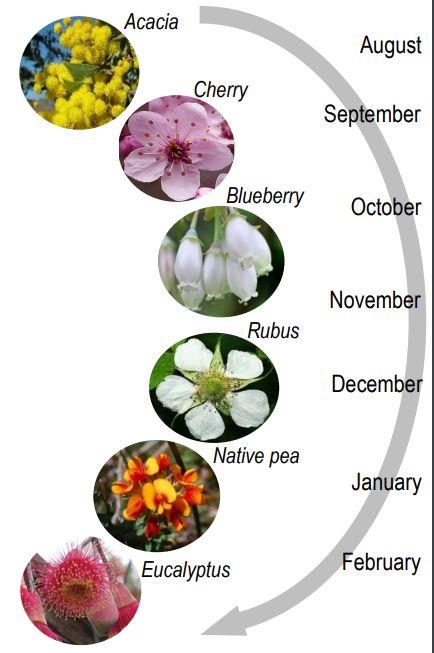Pollination is important to production of many crops, including berries. European honeybees are useful pollinators of raspberries and blackberries, but native bees also play an important role that has been overlooked. We studied which native bee species visit flowers of Rubus pollinate (blackberries and raspberries), how important they are as pollinators, and how growers can encourage native bees.

Our research was undertaken in the Yarra Valley, Victoria, and is likely to be applicable to areas that are similar in having patches of agriculture and moist forest in the same landscape.
Why are native pollinators important?
While some rubus berry cultivars produce fruit without pollination, all are likely to increase yield and fruit quality with bee pollination. We found that native bees are just as effective as honeybees at pollinating blackberries. A single visit by any bee species (honeybee or native) triples the number of drupelets, therefore increasing fruit size.
Which native bees pollinate berries?
Our study identified a number of native bee species visiting raspberry and blackberry flowers. The most common native bees detected visiting flowers and carrying pollen, were reed bees (Exoneura species) and white-banded bees (Lasioglossum species).
Honeybees are declining in many countries due to disease, pesticide use and loss of habitat. Actions to increase the abundance of native bees will reduce the risk of relying on honeybees alone and support better quality and yield of fruit.
Reed Bees (Exoneura species)
Reed bees were the most common flower visitor in some berry orchards. Reed bees are small (approximately 7mm long), and usually have a black upper body and a red-brown abdomen. There are many species in Australia, mostly found in wetter temperate regions (from the tropic of Capricorn in the north, south to Tasmania and west to southwest WA). Reed bees visit a range of crop plants (apples, blueberries, and more) as well as native plants, including some rare species such as orchids.
They are known as reed bees because the females nest in hollowed out pithy stems of plants such as reeds, tree ferns, and grass trees.
They have also been found nesting in non-native plant species such as lantana, brambles and berry canes. Some species have social behaviour, where several females nest in a single stem and work together to raise and protect their brood.

How to encourage native bees

You can encourage a diversity of bees by providing flowers for their feeding and materials for their nesting
Places to nest
Reed bees were found nesting in the canes of raspberry and blackberry. This means that the rubus berry orchard environment provides both a home (nests) and food (flowers) for them to prosper! In one site the density of bees was estimated at 3,000 reed bees per hectare.
We found that reed bees will nest in canes that they can enter at a damage point or an opening created by pruning. New nests are established in spring, but nests are present in the orchard year round. Because they do not tunnel through live tissue they do not harm the plant. Bees prefer canes that are more upright and not too thick (stems less than 9mm diameter were preferred). Further re-search is required to find out if changes to the pruning strategy can help bee nesting. We encourage growers to make their own observations.
You can also provide nesting habitat for reed bees by creating artificial ‘bee hotels’ using cut pieces of rubus canes. We found that bees will sometimes use these, but more research is needed to find out if this boosts the local population above what will nest in the crop itself.
We found that areas of the orchard with more nests in canes also had more reed bee visits to flowers, confirming that the bees live and work locally. They also like nesting in tree ferns and so reed bees were more common in or-chards when tree ferns were nearby.
White-banded bees nest in the soil so their nesting opportunities are less limited. They can be quite abundant in farming landscapes.
Insecticides are harmful to bees, so avoid using them, especially during flowering times. If insecticide use is necessary, favour those that are less harmful to bees. Check the label for advice.
Places to forage
Reed bees actively forage for most of the year (less so in winter), and so require floral resources outside of crop flowering times. We found reed bees foraging on native plants such as Acacia and Hakea before crops were flowering, and Kunzea and Pultenaea after crops finished flowering.
Keep in mind that reed bees might forage hundreds of meters from their nest. Your local area may provide many of these flowering resources at different times of year – your local bushland can support your on farm pollination.

Research by Dr Julian Brown, Dr Saul Cunningham and Joshua Coates, Fenner School of Environment & Society, Australian National University. This project is sup-ported by funding from the Australian Government Department of Agriculture, Water and the Environment as part of its Rural R&D for Profit program.
Citation: Wild bees nest in the stems of cultivated Rubus plants and act as effective crop pollinators, Agriculture Ecosystems & Environment 325(3):107741 February 2022: 10.1016/j.agee.2021.107741

